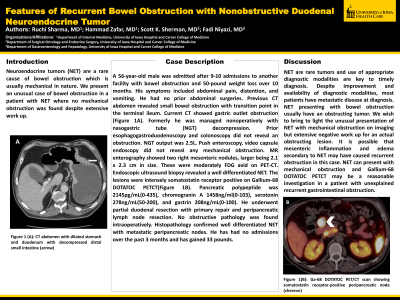Back


Poster Session B - Monday Morning
Category: Small Intestine
B0665 - Features of Recurrent Mechanical Obstruction With Nonobstructive Duodenal Neuroendocrine Tumor
Monday, October 24, 2022
10:00 AM – 12:00 PM ET
Location: Crown Ballroom

Has Audio

Ruchi Sharma, MD
University of Iowa Hospital and Carver College of Medicine
Coralville, IA
Presenting Author(s)
Ruchi Sharma, MBBS, MS, MRCS1, Fadi Niyazi, MD2
1University of Iowa Hospital and Carver College of Medicine, Coralville, IA; 2University of Iowa Hospitals and Clinics, Iowa City, IA
Introduction: Neuroendocrine tumors (NET) are a rare cause of bowel obstruction which is usually mechanical in nature. We present an unusual case of bowel obstruction in a patient with NET where no mechanical obstruction was found despite extensive work up.
Case Description/Methods: A 56-year-old male was admitted after 9-10 admissions to another facility with bowel obstruction and 50-pound weight loss over 10 months. His symptoms included abdominal pain, distention, and vomiting. He had no prior abdominal surgeries. Previous CT abdomen revealed small bowel obstruction with transition point in the terminal ileum. Current CT showed gastric outlet obstruction (Figure 1A). Formerly he was managed nonoperatively with nasogastric tube (NGT) decompression. Prior esophagogastroduodenoscopy and colonoscopy did not reveal an obstruction. NGT output was 2.5L. Push enteroscopy, video capsule endoscopy did not reveal any mechanical obstruction. MR enterography showed two right mesenteric nodules, larger of which was 2.1 x 2.3 cm in size. These were moderately FDG avid on PET-CT. Endoscopic ultrasound biopsy revealed a well differentiated NET. The lesions were intensely somatostatin receptor positive on Gallium-68 DOTATOC PETCT(Figure 1B). Pancreatic polypeptide was 2145pg/mL(0-435), chromogranin A 1458ng/ml(0-103), serotonin 278ng/mL(50-200), and gastrin 208ng/mL(0-100). He underwent partial duodenal resection with primary repair and peripancreatic lymph node resection. No obstructive pathology was found intraoperatively. Histopathology confirmed well differentiated NET with metastatic peripancreatic nodes. He has had no admissions over the past 3 months and has gained 33 pounds.
Discussion: NET are rare tumors and use of appropriate diagnostic modalities are key to timely diagnosis. Despite improvement and availability of diagnostic modalities, most patients have metastatic disease at diagnosis. NET presenting with bowel obstruction usually have an obstructing tumor. We wish to bring to light the unusual presentation of NET with mechanical obstruction on imaging but extensive negative work up for an actual obstructing lesion. It is possible that mesenteric inflammation and edema secondary to NET may have caused recurrent obstruction in this case. NET can present with mechanical obstruction and are often missed on conventional imaging. Gallium-68 DOTATOC PETCT may be a reasonable investigation in a patient with unexplained recurrent gastrointestinal obstruction.

Disclosures:
Ruchi Sharma, MBBS, MS, MRCS1, Fadi Niyazi, MD2. B0665 - Features of Recurrent Mechanical Obstruction With Nonobstructive Duodenal Neuroendocrine Tumor, ACG 2022 Annual Scientific Meeting Abstracts. Charlotte, NC: American College of Gastroenterology.
1University of Iowa Hospital and Carver College of Medicine, Coralville, IA; 2University of Iowa Hospitals and Clinics, Iowa City, IA
Introduction: Neuroendocrine tumors (NET) are a rare cause of bowel obstruction which is usually mechanical in nature. We present an unusual case of bowel obstruction in a patient with NET where no mechanical obstruction was found despite extensive work up.
Case Description/Methods: A 56-year-old male was admitted after 9-10 admissions to another facility with bowel obstruction and 50-pound weight loss over 10 months. His symptoms included abdominal pain, distention, and vomiting. He had no prior abdominal surgeries. Previous CT abdomen revealed small bowel obstruction with transition point in the terminal ileum. Current CT showed gastric outlet obstruction (Figure 1A). Formerly he was managed nonoperatively with nasogastric tube (NGT) decompression. Prior esophagogastroduodenoscopy and colonoscopy did not reveal an obstruction. NGT output was 2.5L. Push enteroscopy, video capsule endoscopy did not reveal any mechanical obstruction. MR enterography showed two right mesenteric nodules, larger of which was 2.1 x 2.3 cm in size. These were moderately FDG avid on PET-CT. Endoscopic ultrasound biopsy revealed a well differentiated NET. The lesions were intensely somatostatin receptor positive on Gallium-68 DOTATOC PETCT(Figure 1B). Pancreatic polypeptide was 2145pg/mL(0-435), chromogranin A 1458ng/ml(0-103), serotonin 278ng/mL(50-200), and gastrin 208ng/mL(0-100). He underwent partial duodenal resection with primary repair and peripancreatic lymph node resection. No obstructive pathology was found intraoperatively. Histopathology confirmed well differentiated NET with metastatic peripancreatic nodes. He has had no admissions over the past 3 months and has gained 33 pounds.
Discussion: NET are rare tumors and use of appropriate diagnostic modalities are key to timely diagnosis. Despite improvement and availability of diagnostic modalities, most patients have metastatic disease at diagnosis. NET presenting with bowel obstruction usually have an obstructing tumor. We wish to bring to light the unusual presentation of NET with mechanical obstruction on imaging but extensive negative work up for an actual obstructing lesion. It is possible that mesenteric inflammation and edema secondary to NET may have caused recurrent obstruction in this case. NET can present with mechanical obstruction and are often missed on conventional imaging. Gallium-68 DOTATOC PETCT may be a reasonable investigation in a patient with unexplained recurrent gastrointestinal obstruction.

Figure: Figure 1 A: CT abdomen with dilated stomach and duodenum and decompressed distal small bowel suggestive of gastric outlet obstruction (arrow) B: Ga-68 DOTATOC PET/CT scan showing somatostatin receptor positive peripancreatic nodules consistent with metastatic neuroendocrine tumor (chevron)
Disclosures:
Ruchi Sharma indicated no relevant financial relationships.
Fadi Niyazi indicated no relevant financial relationships.
Ruchi Sharma, MBBS, MS, MRCS1, Fadi Niyazi, MD2. B0665 - Features of Recurrent Mechanical Obstruction With Nonobstructive Duodenal Neuroendocrine Tumor, ACG 2022 Annual Scientific Meeting Abstracts. Charlotte, NC: American College of Gastroenterology.
